|
|
 |
|
July 31, 2012
I got an email recently from my friend and colleague Tom Maresca with the news that he and his wife, Diane Darrow, have (as he put it) “given birth to a new book,” christened “Not the Same Old Spaghetti Sauce.”
I was glad to receive this birth announcement since I greatly admire Maresca and Darrow’s 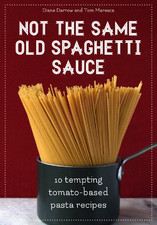 previous books, “La Tavola Italiana” and “The Seasons of the Italian Kitchen.” (Tom also has published two books on wine, “Mastering Wine” and “The Right Wine,” and has also published several guest columns here on Wine Review Online). Like its predecessors, “Not the Same Spaghetti Sauce” has a very distinct Italian flavor, and like them also, the writing and the recipes are clear-cut and engaging. This new book, however, is different in many ways from the first two, and for that matter it’s different from all other cookbooks in my collection. previous books, “La Tavola Italiana” and “The Seasons of the Italian Kitchen.” (Tom also has published two books on wine, “Mastering Wine” and “The Right Wine,” and has also published several guest columns here on Wine Review Online). Like its predecessors, “Not the Same Spaghetti Sauce” has a very distinct Italian flavor, and like them also, the writing and the recipes are clear-cut and engaging. This new book, however, is different in many ways from the first two, and for that matter it’s different from all other cookbooks in my collection.
To begin with, “Not the Same” is a self-described “mini cookbook,” consisting of only ten pasta recipes. All the recipes are tomato based, which is a special blessing this time of year when tomatoes are so wonderfully ripe and flavorful as well as plentiful in back yards, farmers’ markets and farm stands.
Another thing that distinguishes this collection of recipes is that it’s an e-book, published by Hang Time Press and available from Amazon and Barnes & Noble (if you don’t have Kindle or Nook you can download a free reader for your computer on those sites), as well as iTunes. Best of all, “Not the Same Spaghetti Sauce” costs a modest $2.99.
“After innumerable dinners prepared, eaten and cleaned up after together, [Tom and Diane] still
don’t agree on the best way to stack a dishwasher, but they totally agree on the joys of direct, 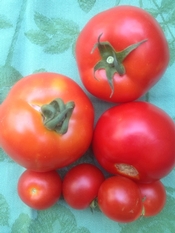 lively flavors treated in simple, straightforward ways.” Their basic approach to food and cooking can be summed up in one bit of advice in the introduction: Get the best ingredients you can lay your hands on and don’t interfere with them. lively flavors treated in simple, straightforward ways.” Their basic approach to food and cooking can be summed up in one bit of advice in the introduction: Get the best ingredients you can lay your hands on and don’t interfere with them.
The book is chockfull of notes about the recipes and ingredients, and thoughtful suggestions for pairing wines with the specific dishes are included. I’m eager to make the Zitti with Fennel Tomato Sauce (“From the first taste we were addicted,” write the authors, describing their introduction to the dish during a visit to wine country near Naples). Mezzani with Eggplant sounds delicious too, but I think the first recipe I’ll tackle is Fusilli with Pork Tenderloin Medallions. “A hearty dish like this wants a hearty wine to stand up to it,” the authors advise. “Try either a good Pugliese Primitivo or a Monepulcianno d’Abruzzo. A fruity, simple Zinfandel will work well too. Ample acidity and plenty of fruit are keys to the match.”
In the introduction to this recipe Tom and Diane write, “Pork in any form--chops, shanks, sausages--makes magic when combined with tomatoes.” My mouth is watering already, so I’m heading off now to buy a pork tenderloin….
Posted by Marguerite Thomas at 8:46 AM
|
|
July 19, 2012
Creators Syndicate
Once upon a time in American viticulture, it was fashionable — some would
even argue necessary — to tag domestic wines with European place-names.
E&J Gallo, for example, had its uber-successful jug wine that it called
Hearty Burgundy. And various sparkling wine producers, including Korbel and
Schramsberg, often referred to their product as Champagne.
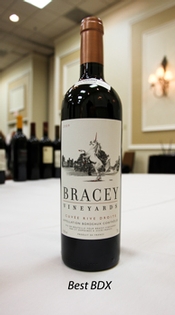 Of course, the red wine of France's Burgundy region is pinot noir,
and it's a good bet that that particular grape never found its way into a bottle
of Hearty Burgundy. And the fizzy adult beverages being made in California and
New York resembled authentic Champagne from France in only one sense: They had
bubbles. Of course, the red wine of France's Burgundy region is pinot noir,
and it's a good bet that that particular grape never found its way into a bottle
of Hearty Burgundy. And the fizzy adult beverages being made in California and
New York resembled authentic Champagne from France in only one sense: They had
bubbles.
Then there was the ubiquitous "Chablis" being sold throughout America. It
seemed every white wine coming out of California was called Chablis, even though
it might not have so much as a drop of chardonnay, the grape of the Chablis
region of France.
It wasn't that long ago that marketing strategy and sentiment shifted, and
wines in the U.S. began to be labeled by the grape name. But that still
presented an identity issue for winemakers who wanted to make blended red wines
based upon another French model — Bordeaux.
Located in southwest France near the Atlantic Ocean, Bordeaux had long
practiced the art of blending multiple grape varieties. The reason was
commercial more than aesthetic. Some of the best grapes of Bordeaux,
particularly the late-ripening cabernet sauvignon, would not fully ripen every
vintage in the daunting climate of the region, where hail in summer and rain in
autumn can be devastating to vineyards.
Five red grape varieties evolved over time as the principle grapes of
Bordeaux: cabernet sauvignon, cabernet franc, merlot, petit verdot and Malbec,
with cabernet sauvignon, merlot and cabernet franc holding the most important
positions in the construct of Bordeaux viticulture.
With its access to world markets because of its proximity to the sea,
Bordeaux over time became the world's most prestigious wine. It was only
natural, then, that when the wine boom hit California in the late 1960s, there
was a stampede to plant the grapes of Bordeaux. Nothing sells like success.
But the question remained: What to call it? From this conundrum, the term
"meritage" was born. Although many assume the word is French and attempt to give
it a French pronunciation, the term was actually created by merging the words
American and heritage, and the Meritage Alliance, headquartered in California,
was born.
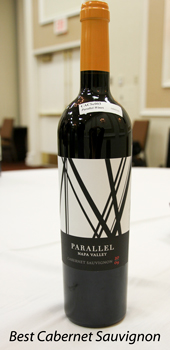 Meritage wines are simply the Bordeaux-style blends created to
replicate the wines of Bordeaux made from any combination of cabernet sauvignon,
cabernet franc, merlot, petit verdot and Malbec grapes. The most famous meritage
is perhaps the very first, Joseph Phelps Insignia, which has been around for
three decades and pre-dates the term. Meritage wines are simply the Bordeaux-style blends created to
replicate the wines of Bordeaux made from any combination of cabernet sauvignon,
cabernet franc, merlot, petit verdot and Malbec grapes. The most famous meritage
is perhaps the very first, Joseph Phelps Insignia, which has been around for
three decades and pre-dates the term.
Over the past weekend, I launched a
new wine competition, Mainly Meritage, that was limited exclusively to wines
made from the traditional grapes of Bordeaux. Mainly Meritage is a niche event
that likely will never be huge in numbers, but it takes me back to my roots (it
was my passion for Bordeaux that inspired my career as a wine journalist), and
the quality of the wines submitted is guaranteed to be very high. For me, Mainly
Meritage is a labor of love.
That high quality is assured at Mainly
Meritage should be easy to understand. Most wineries that work with the Bordeaux
grape varieties reserve their very best stocks for a Bordeaux-style blend, which
in most cases is their flagship wine. Mainly Meritage was open to wineries that
belong to the Meritage Alliance as well as wineries that simply make wine from
the Bordeaux grapes.
Entries for the first Mainly Meritage were evaluated
by winemakers, sommeliers and other wine professionals in a single day of
judging that produced its share of surprises.
The winner of best BDX
blend (BDX is a common reference for Bordeaux) was a garagiste wine from
Bordeaux, the 2009 Bracey Cuvee Rive Droite, Bordeaux AOC ($105). Robert Bracey
is an American who makes wine in Bordeaux, Burgundy and here in the United
States. In fact, his 2006 Bracey Vineyards Cabernet Sauvignon, Howell Mountain,
Napa Valley ($65) took the crown of Best Red Wine at the 2011 Sommelier
Challenge International Wine Competition.
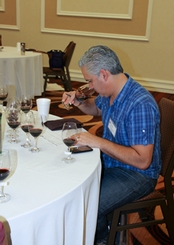 Garagiste
refers to the new generation of winemakers in Bordeaux who eschew the
traditional chateau approach and make what are called "garage" wines. Bracey's
Cuvee Rive Droite emerged from a category for "right bank BDX blends." The
so-called right-bank of Bordeaux, which includes the important AOC wines of
Saint-Emilion and Pomerol, is dominated by merlot and cabernet franc, with very
little cabernet sauvignon planted. Garagiste
refers to the new generation of winemakers in Bordeaux who eschew the
traditional chateau approach and make what are called "garage" wines. Bracey's
Cuvee Rive Droite emerged from a category for "right bank BDX blends." The
so-called right-bank of Bordeaux, which includes the important AOC wines of
Saint-Emilion and Pomerol, is dominated by merlot and cabernet franc, with very
little cabernet sauvignon planted.
The right-bank category at Mainly Meritage requires a wine to have less than
50 percent cabernet sauvignon. Bracey Cuvee Rive Droite is 73 percent Merlot, 23
percent cabernet franc and 3 percent cabernet sauvignon.
The Left Bank BDX was a tie between Napa Valley powerhouse V. Sattui, with
its 2008 Paradiso ($65), and another wine from Bracey, the 2009 Cuvee Rive
Gauche ($120). Left-bank blends at Mainly Meritage required a minimum of 50
percent cabernet sauvignon.
The Napa Valley also produced the winner of the award for best cabernet
sauvignon, the 2009 Parallel Cabernet Sauvignon ($60), and scads of gold medals
for big-hitters such as Cakebread Cellars, Pine Ridge Winery, Flora Springs, St.
Supery Vineyards & Winery and Frank Family Vineyards.
Best Meritage was awarded to Washington's Lake Chelan Winery for its 2008
Maximum 5, Columbia Valley ($45).
In something of a surprise, the Fallbrook Winery in Southern
California took the top awards for both cabernet franc and sauvignon blanc
Posted by Robert Whitley at 11:38 AM
|
|
July 6, 2012
If you’re looking for some lively, unique and affordable wines for relaxed summer drinking, consider some of the offerings from Portugal’s Vinho Verde region. You may remember Vinho Verde as a simple, pleasant-but-boring white wine with a little bit of spritz to set it apart from 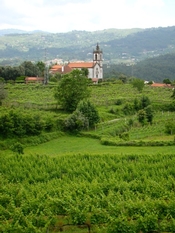 other ho-hum summer sippers. But if you haven’t tried any wines from the Vinho Verde region recently, you could be in for a pleasant surprise. other ho-hum summer sippers. But if you haven’t tried any wines from the Vinho Verde region recently, you could be in for a pleasant surprise.
Although red Vinho Verde is produced in relatively small amounts, what most people are more familiar with is the region’s white wines. Among Vinho Verde’s several different white wine grapes, the most prevalent is Alvarinho (this is the same grape found just across the Minho River in Spain’s Galicia region, where its name is Albariño). Top white wine grapes also include Loureiro (which yields fragrant, fresh wines) and Trajadura (these wines can be soft and opulent). Among other whites are Espadeiro (frequently used for sparkling wine), Avesso and Azal Branco.
One reason Vinho Verde white wines have such summery appeal is that they tend to be delicately textured and infused with attractive, lightly floral fragrance and gentle flavors. They are frequently spine-tinglingly crisp (without being sour) and they’re generally low in alcohol. For the most part Vinho Verde wines are simple and easygoing, but increasingly one can find some that have impressive balance and genuine complexity.
White wines from Vinho Verde outnumber reds by far, but there is a push on in the region to increase the production of fine red wine. This goal is more attainable today thanks to a couple of factors. One is the slight but significant increase in overall temperature that allows grapes in cooler regions such as northern Portugal to ripen thoroughly. Equally significant are the advances in knowledge and technology in vineyards and wineries (and of course all these factors influence white wine as well as red wine production).
Getting to know Vinho Verde red wine is easy in that you don’t have to master an entire lexicon of different grape varieties since the single most prevalent red wine grape by far is Vinhäo. I will admit, however, that Vinhão based wine is not immediately easy to love, especially in a world that favors big, fruity, smooth, velvety red wines. The truth is that Vinhão is most often rustic, austere, even tart. But I find that when well made, it can be terrific with the sort of rich, fatty, meaty foods for which the Iberian Peninsula is known. Lamb, for example, as well as ham, sausage and other cured or smoked meats can be delicious with good Vinhão. “It’s not a wine for export,” one producer told me. “It is better to import people to Portugal and have them drink it here.”
I would certainly recommend an expedition to Vinho Verde, and not only for the purpose of sampling the wines. Anyone looking for a vacation venue that’s off the beaten path, with lovely landscapes and charming small towns is sure to appreciate this little corner of earthly paradise. Personally, I would return in a heartbeat for a closer look at the cultural center of Guimarães. I had time only for a quick overview of this UNESCO World Heritage site known for its remarkably well preserved evolution of ancient-to-medieval architecture (Guimarães’ oldest streets date back to the 10th century). I would also go back to Ponte de Lima. Said to be the oldest village in Portugal, Ponte de Lima is a beautiful town known today for its many palaces and mansions, and for its Roman/Medieval bridge spanning the Ponte River. But until I get a chance to revisit these places, I’ll settle for some of the region’s wines at home, and I recommend you do the same. Here are a few Vinho Verde labels that are available in the US market.
Casal do Paço Padreiro: From the “Afros” line from this organic and Biodynamic producer, try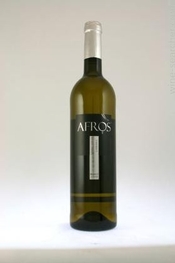 Loureiro, and sparkling Loureiro. Afros Vinhão is one of the few Vinhãos imported into the US, and well worth seeking out if you’re an adventuresome wine drinker. And if, like me, you appreciate sparkling dry red wines by all means pick up a bottle or two of Afros sparkling Vinhão (thoroughly chilled, this can be a refreshing and fun wine to pour when regular reds seem too hot and heavy for a warm summer day). All Afros wines tend to be serious, lean and sophisticated, and are priced between $15 and $22. Imported by Skurnik. Loureiro, and sparkling Loureiro. Afros Vinhão is one of the few Vinhãos imported into the US, and well worth seeking out if you’re an adventuresome wine drinker. And if, like me, you appreciate sparkling dry red wines by all means pick up a bottle or two of Afros sparkling Vinhão (thoroughly chilled, this can be a refreshing and fun wine to pour when regular reds seem too hot and heavy for a warm summer day). All Afros wines tend to be serious, lean and sophisticated, and are priced between $15 and $22. Imported by Skurnik.
Gomariz: Succulent Gomariz Loureiro conveys the richness of melon and the brightness of lime peel. The Alvarinho combines remarkably delicacy with complexity. Gomariz Vinhão is substantial enough to serve with pork or chicken, and its always good with simple dishes such as pasta with tomato based sauce. Be sure to chill Vinhão before serving this unusual red wine. Prices range from $13 to $18. Imported by P.R. Grisley.
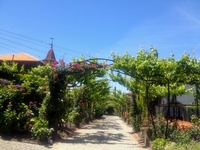 Quinta da Aveleda: This is a beautiful estate renowned for its gorgeous gardens as well as its infinitely approachable white wines. Several different whites from Aveleda are available in the US, including the wonderfully crisp and refreshing Vinho Verde (made from Loureiro, Trajadura and Arinto grapes) to the richer, somewhat more complex Aveleda Alvarinho. Prices range from $8 to $13. Imported by TriVin.
Posted by Marguerite Thomas at 12:18 PM Quinta da Aveleda: This is a beautiful estate renowned for its gorgeous gardens as well as its infinitely approachable white wines. Several different whites from Aveleda are available in the US, including the wonderfully crisp and refreshing Vinho Verde (made from Loureiro, Trajadura and Arinto grapes) to the richer, somewhat more complex Aveleda Alvarinho. Prices range from $8 to $13. Imported by TriVin.
Posted by Marguerite Thomas at 12:18 PM
|
|
 |
|